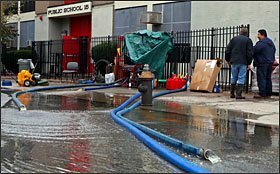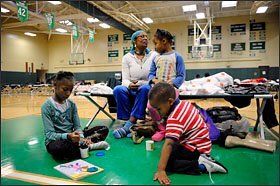In the days after Hurricane Sandy battered the Eastern Seaboard, educators across multiple states faced the daunting task of reopening thousands of schools amid widespread power outages, flooding and wind damage, and other aftereffects of a storm that caused one of the largest disruptions to schooling in the United States in recent years.
The 1.1 million students in the New York City system were out of school for five straight days this week—the longest districtwide disruption in the history of that school system other than teacher strikes. Officials there were preparing to reopen next week as authorities scrambled to restore power, pump out floodwaters, clean up debris, and restart, at least partially, the city’s vast system of buses and subway transportation widely used by students.
Hundreds of districts in New York state and New Jersey—where what was soon dubbed the “superstorm” made landfall early this week—were shuttered following the storm, with many likely to remain closed into next week. Schools from North Carolina to Maine and as far west as West Virginia and Ohio were also shut down for part of the week because of the reach of the storm, which had killed at least 98 people in the United States as of a Nov. 2 report by Reuters.
“We’ve never experienced anything on this scale before,” said Janine Walker Caffrey, the superintendent of schools in Perth Amboy, N.J., a small industrial city whose waterfront on Raritan Bay was destroyed in the storm. “It’s just devastating to so many people and so many communities.”
Historical Perspective

Other storms and crisis events in the United States have delivered blows to schooling in recent years:
• Hurricane Katrina in 2005 destroyed schools across the Gulf Coast states and radically reshaped the education landscape in New Orleans, where more than 60,000 children attended public schools before the storm. Many New Orleans schools were closed for months, and once they began reopening, most did so as independent charter schools overseen by a state-run district. Enrollment has never recovered to pre-Katrina levels; the city’s charter and traditional public schools served roughly 40,000 students last school year.
• The terror attacks of Sept. 11, 2001, in New York City, the Washington area, and rural Pennsylvania caused some disruption, though in New York City, the school system shut down for only one day after the attacks on the World Trade Center, and a handful of schools in Lower Manhattan had to be relocated.
• And in storm-prone Florida, Hurricane Frances in 2004 damaged every school in the 40,000-student St. Lucie County district, where a second storm, Jeanne, followed close behind, forcing the system to stay shut down for a month.
But none of those events matches the geographic expanse of the destruction that Hurricane Sandy has dealt the most populous region of the United States.
With millions of children out of class for days, school administrators in some of the hardest-hit communities were still waiting for the lights to come on late this week so they could start the arduous process of assessing the scope of damage to their buildings.
Repair Begins
In Newark, New Jersey’s largest district, with 40,000 students, restoring power to all 75 school buildings was the first major obstacle, said Superintendent Cami Anderson. Without power, crews couldn’t get inside many of the buildings until a full two days after the storm to start careful inspections of every corner for safety and to check the condition of boilers, she said.
As was the case in much of the devastated region, three of Newark’s schools were being used as emergency shelters for residents, and a fourth was serving as a central kitchen to prepare 1,000 meals a day for one of the city’s other emergency shelters, Ms. Anderson said.
The district was largely spared from flooding, Ms. Anderson said, which she called the “only silver lining in this whole scenario.”

Ms. Caffrey, whose district serves 10,500 children, said the roof on a building that houses 450 students in Perth Amboy High School’s stem Academy was destroyed. A number of other school buildings also flooded because the city’s entire seawall was breached in the storm, she said. The district’s small fleet of sailboats for the high school sailing team was washed away.
The district already had a fall break scheduled for this week, and Ms. Caffrey hopes that will give her team enough time to clean up and reopen by Nov. 12.
Christopher Cerf, the state education commissioner in New Jersey, said that the disruptions to schooling were unprecedented in his state, and that soon school leaders would have to determine whether days must be added to the school year. The state requires a minimum of 180 instructional days, but many districts have requirements for as many as 185 days, Mr. Cerf said.
“Our educators are scrambling as best they can to get schools back up and running and, if they have to, exploring options for alternative spaces,” he said. “We will move heaven and earth to make sure that every child in New Jersey gets the amount of instructional time they need. We can’t afford to let them lose that time.”
In a news conference this week, New York City Mayor Michael R. Bloomberg acknowledged the challenge for parents, but with as many as 200 school buildings out of 1,400 sustaining storm-related damage and mass transit still very limited, the mayor said schools in his city would not be able to resume before next week.
“I know this is a great inconvenience for parents,” the mayor said.
Myriad Challenges
Even in districts where physical damage was relatively minor, there were major challenges to address before schools could reopen.
In Paterson, N.J., the state’s third-largest district, with nearly 30,000 students, power was still out in numerous schools, and those where it had been restored were experiencing brownouts late this week, district spokeswoman Terry Corallo said in an email.
Ms. Corallo said that the district’s buildings were “fine structurally,” but that “significant amounts of food stored in school freezers” had been lost and would present a challenge for feeding students breakfasts and lunches. Another obstacle for Paterson, she said, is that many of the district’s employees live in other parts of New Jersey or in New York, and that commuting remained difficult because of downed trees and power lines.
Educators were also anticipating how to address the psychological toll that the storm may have taken on students and staff members.
Ms. Caffrey said that she was particularly concerned about children in the hundreds of Perth Amboy families that did not leave the city ahead of the storm.
“They experienced and saw some scary stuff with the water coming into the city,” she said.
In New York and New Jersey, some children at storm shelters were treated to “child-friendly spaces” provided by Save the Children, a nonprofit based in Westport, Conn., that provides numerous supports and services to children in need worldwide. The spaces provided a place for children to play, socialize, and escape from the surrounding scenes of disaster; they gave parents time to register for emergency assistance, handle other issues, and just take a break.
“The kids love it,” said Amy Richmond, a child-protection supervisor with the organization who was working to distribute the kits to shelters in inland New Jersey. At her first stop, children quickly flocked to her, grabbing jump ropes to burn off pent-up energy. Children at the Burlington, N.J., shelter and their families were evacuees from Long Beach Island, N.J., and expect to be at the shelter for up to two weeks, she said.
The play equipment also gives children an outlet to express their feelings—a step to healing.
“They wanted to color,” Ms. Richmond said. “Immediately, without being prompted at all, one of the girls said, ‘I want to draw my house,’ ” Ms. Richmond said.
The houses they drew?
“They were intact, but there was lots of water.”






